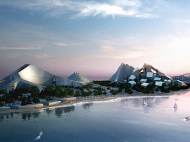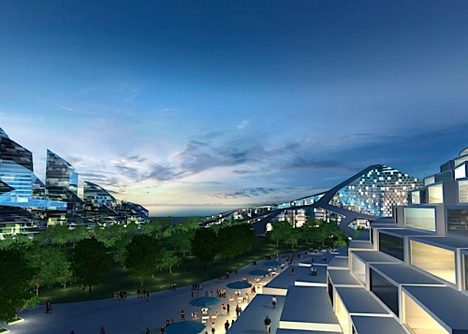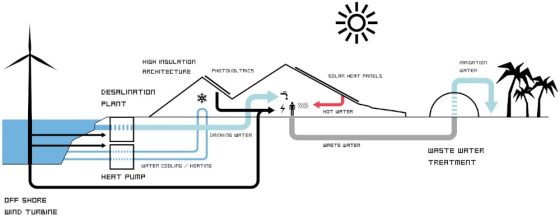Green architecture – Zira Island in Azerbaijan
 Carbon neutral master plans are being adopted increasingly in times when energy and emissions are becoming important. And that’s exactly what Azerbaijan will do to develop Zira Island, located in the bay of Caspian Sea next to the capital city Baku. Besides being carbon neutral, this project will make a self-sufficient resort out of a current desert island. The master plan was developed with Danish BIG Architects and Ramboll engineers, with an architectural proposal based upon the country’s dramatic natural setting. The island has 1 million square meters and it will feature architecture which mimics the shape of the seven mountain peaks of Azerbaijan. This mountain concept may sound strange, but BIG has already implemented that idea in their earlier Mountain Dwellings project.
Carbon neutral master plans are being adopted increasingly in times when energy and emissions are becoming important. And that’s exactly what Azerbaijan will do to develop Zira Island, located in the bay of Caspian Sea next to the capital city Baku. Besides being carbon neutral, this project will make a self-sufficient resort out of a current desert island. The master plan was developed with Danish BIG Architects and Ramboll engineers, with an architectural proposal based upon the country’s dramatic natural setting. The island has 1 million square meters and it will feature architecture which mimics the shape of the seven mountain peaks of Azerbaijan. This mountain concept may sound strange, but BIG has already implemented that idea in their earlier Mountain Dwellings project.
Bjarke Ingels, principal of BIG said: “What we propose for Zira Zero Island is an architectural landscape based on the natural landscape of Azerbaijan. This new architecture not only recreates the iconic silhouettes of the seven peaks, but more importantly creates an autonomous ecosystem where the flow of air, water, heat and energy are channeled in almost natural ways. A mountain creates biotopes and eco-niches, it channels water and stores heat, it provides viewpoints and valleys, access and shelter. The Seven Peaks of Azerbaijan are not only metaphors, but actual living models of the mountainous ecosystems of Azerbaijan.”
Each of the Seven Peaks house a residential development derived from the geometry of a famous mountain in Azerbaijan. Individually each mountain becomes a principle for mixing private and public functions. Together the mountains form an organic skyline merging with the natural topography of the island. A dense vibrant urban community is connected with a series of private resort villages by a central public valley and surrounding beaches. A continuous public path connects the mountains and invites visitors to visit the top of all seven peaks.
The vision for Zira Island is to create an improved environment that is entirely independent of external resources – a self sufficient island. By combining the best of the traditional Azerbaijani building tradition and the newest technology, Zira Island will provide excellent living spaces for people, with a minimum usage of resources. In addition to the Seven Peaks the Master Plan also includes 300 private villas that take advantage of their setting with panoramic views of the Caspian Sea.
The buildings on the island will be heated and cooled by heat pumps connected to the surrounding Caspian Sea. Solar heat panels integrated in the architecture create a steady supply of hot water, while photovoltaic cells on strategically located facades and roof tops power daytime functions like swimming pools and aqua parks.
Waste water and storm water are collected and led to a waste water treatment plant to be cleaned, processed and recycled for irrigation. The solid parts of the waste water are processed, composted and finally turned into top soil, thus fertilizing the island. The constant irrigation and fertilization of the island supports the lush green condition of a tropical island, with a minimal ecological footprint.
Zira Island also benefits from the fact that Baku is “the city of wind”. By harvesting the wind energy through an offshore wind farm, the island will have its own carbon neutral power supply. With usage of wind turbine platforms it provides the existing offshore oil industry’s platforms & foundations in Baku a more sustainable future.
The landscaping of the island is derived from wind simulations of the micro-climates created by the mountains. The patterns created by the wind moving its way through the Seven Peaks gave information important for the vegetation planting and the design of public spaces. Where the winds and turbulence are strongest the tree planting becomes denser, thus creating lower wind speeds and a comfortable outdoor leisure climate.
Lars Ostenfeld Riemann, director of Ramboll’s Group, said: “Zira Island will be an important step into the future of urban development in Caucasus and Central Asia. By help of the wind, the sun and the waste the Island will produce the same amount of energy as it consumes. In a society literately built on oil this will serve as a showcase for a new way of thinking – sustainable planning. From an engineering point of view we are just as thrilled by the challenge of letting the design of the buildings reflect the shape of the mountains of Azerbaijan.”











Leave your response!